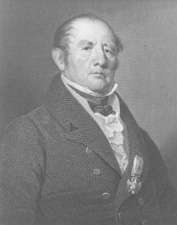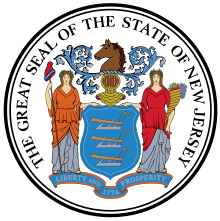Aaron Ogden
| Aaron Ogden | |
|---|---|
 | |
| 5th Governor of New Jersey | |
|
In office October 29, 1812 – October 29, 1813 | |
| Preceded by | Joseph Bloomfield |
| Succeeded by | William Sanford Pennington |
| United States Senator from New Jersey | |
|
In office February 28, 1801 – March 3, 1803 | |
| Preceded by | James Schureman |
| Succeeded by | John Condit |
| Member of the New Jersey General Assembly | |
|
In office 1803–1812 | |
| Personal details | |
| Born |
December 3, 1756 Elizabethtown, Province of New Jersey, British America |
| Died |
April 19, 1839 (aged 82) Jersey City, New Jersey, U.S. |
| Political party | Federalist |
| Spouse(s) | Elizabeth Chetwood |
| Relations |
Matthias Ogden (brother) Frederick Ogden (grandson) William Chetwood (brother-in-law) |
| Children | 7, including Elias |
| Alma mater | College of New Jersey |
| Military service | |
| Allegiance |
|
| Service/branch |
|
| Rank | Brigade major |
| Unit | 1st New Jersey Regiment |
| Battles/wars | Revolutionary War |
Aaron Ogden (December 3, 1756 – April 19, 1839) was an American soldier, lawyer, United States Senator and the fifth Governor of New Jersey.[1] Ogden is perhaps best known today as the defendant in Gibbons v. Ogden which destroyed the monopoly power of steamboats on the Hudson River in 1824.[2]
Early life
Ogden was born in Elizabethtown (known today as "Elizabeth") in the Province of New Jersey. He was the son of Robert Ogden, a lawyer and public official who served as Speaker of the New Jersey lower house immediately preceding the Revolution,[2] and Phebe (née Hatfield) Ogden.[3] Ogden's brother Matthias Ogden (1754–1791) was a Revolutionary War soldier and his nephew, Daniel Haines also served as Governor of New Jersey on two separate occasions.[4]
Ogden, a Presbyterian, graduated from the College of New Jersey (now Princeton University) in 1773, and served as a grammar school tutor from 1773 to 1775.[5]
Career
In the American Revolutionary War, Ogden was appointed a lieutenant in the 1st New Jersey Regiment; his older brother Matthias Ogden was the lieutenant colonel. Aaron Ogden served in various roles through the war, seeing action and rising to the rank of brigade major.[6] In 1778, he visited the house also occupied by the family of diarist Sally Wister, who described him as "a genteel young fellow, with an aquiline nose."[7] He was wounded at the siege of Yorktown in 1781.[8]
Ogden was an original member of the Pennsylvania Society of the Cincinnati. He served as the Society's President General from 1829 until his death in 1839.[8]
Political career
After the war, Ogden studied law and was admitted to the bar in 1784. He commenced practice in Elizabeth and served as a presidential elector in the 1796 electoral college that elected John Adams. He was clerk of Essex County from 1785–1803, and was elected as a Federalist to the United States Senate to fill the vacancy caused by the resignation of James Schureman and served from February 28, 1801 to March 3, 1803. He lost his bid for reelection to the Senate in 1802.[1]
In 1803, Ogden was elected to the New Jersey General Assembly, where he served until 1812. Ogden was elected trustee of the College of New Jersey (later to become Princeton University) in 1803, a post in which he served until his death.[1]
In 1812, Ogden was elected as Governor of New Jersey in a wave of Federalist victories across the state due to opposition to the War of 1812.[2] Ogden had been nominated by his Federalist colleagues as governor many times before, but the Republican majority who elected the governor held the majority from 1803 to 1812.[2] During his term as Governor, "funds were secured for the military's use in the war against Britain."[9] After running unsuccessfully for reelection, the Federalists were voted out of the majority and with them, Ogden retired from political life.[2] Ogden was nominated by President James Madison as major general of the Army in 1813, but declined the appointment.[1]
Steamboat operations
In 1811, he became engaged in steamboat navigation by building the steamboat Sea Horse to run between Elizabeth and New York City.[10] In 1812, under Livingston v. Van Ingen, the courts chose to upheld a steamboat monopoly over the Hudson River.[11][12] In 1813, the New York State Legislature further upheld the monopoly created by Chancellor Robert Livingston and Robert Fulton, who had designed the steamboat,[13] so Ogden agreed to pay them for a ten-year monopoly to run his line.[10]
As a result of a feud with his neighbor and competing steamboat operator, Thomas Gibbons, Ogden was a defendant in the Gibbons v. Ogden case that denied New York State's attempted monopoly on steamboat operation between New York and New Jersey. In the case, which eventually was decided by the U.S. Supreme Court in 1824, Ogden was represented by Samuel L. Southard and Joseph Hopkinson, Livingston by Thomas Addis Emmet, and Gibbons by Daniel Webster and U.S. Attorney General William Wirt.[14]
Later life
Ogden moved to Jersey City in 1829 and resumed the practice of law. It was in Jersey City where he was arrested for debt and sent to debtors' prison.[8] He was released several months later under an act of the Legislature that provided "that no Revolutionary officer or soldier should be imprisoned for debt. The law was so framed as to cover the case of Col. Ogden, and he was released."[8] In 1830, he was appointed as Collector of Customs of Jersey City, an office created specifically for him by an act of Congress,[8] and served until his death in Jersey City.[1]
Personal life

Ogden was married to Elizabeth Chetwood (1766–1826), the daughter of John Chetwood, an attorney, and Mary (née Emott) Chetwood (d. 1786). She was the older sister of U.S. Representative and Mayor of Elizabeth William Chetwood (1771–1857). Together, they were the parents of:[8]
- Mary Chetwood Ogden (1789–1863), who was married to George Clinton Barber.[8]
- Phebe Ann Ogden (1790–1865), who served as Vice Regent of the Mount Vernon Ladies' Association.[8]
- Matthias Ogden (1792–1860), who married Lucille Robert.[8]
- John Robert Ogden (1794–1845), who did not marry.[8]
- Elias Bailey Dayton Ogden (1797–1799), who died young.[8]
- Elias Bailey Dayton Ogden (1800–1865), who was named after his deceased brother. Elias, who married three times, served as an associate justice of the New Jersey Supreme Court from 1842 until his death in 1865.[8]
- Aaron Ogden Jr. (1803–1803), who died young.[8]
Ogden died in Jersey City, New Jersey on April 19, 1839. Ogden's body is interred at the burial ground of the First Presbyterian Church of Elizabeth.[1]
Descendants
Through his son Elias, he was the grandfather of Frederick Beasley Ogden (1827–1893), who served as Mayor of Hoboken, New Jersey from 1865 to 1867; Aaron Ogden (1828–1896), who married Harriet Emily Travers; and Susan Dayton Ogden (1831–1878), who married William Shepard Biddle, and were the parents of U.S. Army general John Biddle.[15]
See also
References
- Notes
- 1 2 3 4 5 6 "OGDEN, Aaron - Biographical Information". bioguide.congress.gov. Biographical Directory of the United States Congress. Retrieved 23 February 2018.
- 1 2 3 4 5 Birkner, Michael J.; Linky, Donald; Mickulas, Peter (2014). The Governors of New Jersey: Biographical Essays. Rutgers University Press. p. 1789. ISBN 9780813571775.
- ↑ "The New Netherlands Ancestors of Aaron Ogden". Rootsweb. Ancestry.com.
- ↑ Longacre, James Barton (1834). The National Portrait Gallery of Distinguished Americans. Bancroft. p. 79. Retrieved 23 February 2018.
- ↑ Denslow, William R. (1959). 10,000 Famous Freemasons from K to Z, Volume 3. Missouri Lodge of Research. p. 282.
- ↑ Legislative history of the General staff of the Army of the United States: (its organization, duties, pay, and allowances), from 1775 to 1901. Government Printing Office. 1901. p. 60.
- ↑ Sally Wister, ‘‘Sally Wister's Journal: A True Narrative: Being a Quaker Maiden's Account of Her Experiences with Officers of the Continental Army, 1777–1779’’. Applewood Books, Bedford, Massachusetts, 1994. Entry for May 11, 1778.
- 1 2 3 4 5 6 7 8 9 10 11 12 13 Alstyne, Lawrence Van; Ogden, Charles Burr (1907). The Ogden family in America, Elizabethtown branch, and their English ancestry: John Ogden, the Pilgrim, and his descendants, 1640-1906. Printed for private circulation by J.B. Lippincott company. p. 138. Retrieved 23 February 2018.
- ↑ "Aaron Ogden". www.nga.org. National Governors Association. Retrieved 23 February 2018.
- 1 2 "Steamboats on the Hudson: An American Saga - Aaron Ogden". www.nysl.nysed.gov. New York State Library. Retrieved 23 February 2018.
- ↑ "Livingston v. Van Ingen | New York Steamboat Monopoly". www.nycourts.gov. The Historical Society of the New York Courts. Retrieved 23 February 2018.
- ↑ "Gibbons v. Ogden". www.nycourts.gov. The Historical Society of the New York Courts. Retrieved 23 February 2018.
- ↑ Athearn, Robert G. (1988). American Heritage Illustrated History of the United States. Choice Pub. p. 164. ISBN 9780945260059. Retrieved 22 February 2018.
- ↑ Cox, Thomas H. (2009). Gibbons v. Ogden, Law, and Society in the Early Republic. Ohio University Press. ISBN 9780821418468. Retrieved 22 February 2018.
- ↑ Owen Picton (May 2004). "Descendants of William Biddle III". Archived from the original on November 18, 2010. Retrieved March 16, 2011.
- Sources
- Baxter, Maurice G. Dictionary of American Biography
- The Steamboat Monopoly: Gibbons v. Ogden, 1824. New York: Alfred A. Knopf, 1972.
- Ogden, Aaron. Autobiography of Col. Aaron Ogden, of Elizabethtown. Paterson, NJ: Press Printing & Publishing Co., 1893.
- Purcell, L. Edward. Who Was Who in the American Revolution. New York: Facts on File, 1993. ISBN 0-8160-2107-4.
External links
- United States Congress. "Aaron Ogden (id: O000041)". Biographical Directory of the United States Congress. Retrieved on 2009-02-26
- Biography of Aaron Ogden (PDF), New Jersey State Library
- New Jersey Governor Aaron Ogden, National Governors Association
- Dead Governors of New Jersey bio for Aaron Ogden
| U.S. Senate | ||
|---|---|---|
| Preceded by James Schureman |
U.S. Senator (Class 1) from New Jersey February 28, 1801 – March 3, 1803 Served alongside: Jonathan Dayton |
Succeeded by John Condit |
| Political offices | ||
| Preceded by Joseph Bloomfield |
Governor of New Jersey October 29, 1812 – October 29, 1813 |
Succeeded by William Sanford Pennington |

